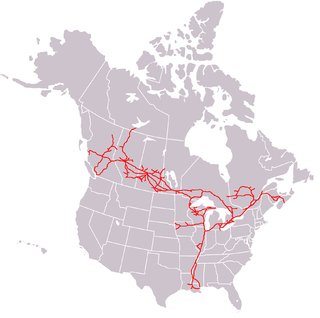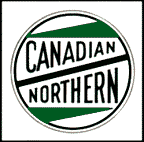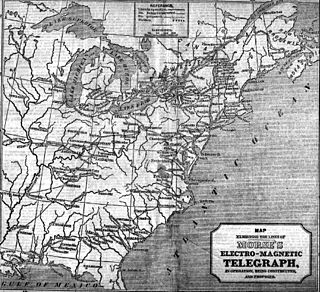Present-day telecommunications in Canada include telephone, radio, television, and internet usage. In the past, telecommunications included telegraphy available through Canadian Pacific and Canadian National.

The Canadian Pacific Railway, also known simply as CPR or Canadian Pacific and formerly as CP Rail (1968–1996), is a Canadian Class I railway incorporated in 1881. The railway is owned by Canadian Pacific Railway Limited, which began operations as legal owner in a corporate restructuring in 2001.

Electrical telegraphs were point-to-point text messaging systems, primarily used from the 1840s until the late 20th century. It was the first electrical telecommunications system and the most widely used of a number of early messaging systems called telegraphs, that were devised to communicate text messages quicker than physical transportation. Electrical telegraphy can be considered to be the first example of electrical engineering.

Sir Alexander Tilloch Galt, was a politician and Founding Father of the Canadian Confederation.

Bell Canada is a Canadian telecommunications company headquartered at 1 Carrefour Alexander-Graham-Bell in the borough of Verdun in Montreal, Quebec, Canada. It is an ILEC in the provinces of Ontario and Quebec; as such, it was a founding member of the Stentor Alliance. It is also a CLEC for enterprise customers in the western provinces.

The Canadian National Railway Company is a Canadian Class I freight railway headquartered in Montreal, Quebec, which serves Canada and the Midwestern and Southern United States.
The Dominion Land Survey is the method used to divide most of Western Canada into one-square-mile (2.6 km2) sections for agricultural and other purposes. It is based on the layout of the Public Land Survey System used in the United States, but has several differences. The DLS is the dominant survey method in the Prairie provinces, and it is also used in British Columbia along the Railway Belt, and in the Peace River Block in the northeast of the province.

The Canadian Northern Railway (CNoR) was a historic Canadian transcontinental railway. At its 1923 merger into the Canadian National Railway, the CNoR owned a main line between Quebec City and Vancouver via Ottawa, Winnipeg, and Edmonton.

The Newfoundland Railway operated on the island of Newfoundland from 1898 to 1988. With a total track length of 906 miles (1,458 km), it was the longest 3 ft 6 in narrow-gauge railway system in North America.
Canadian Pacific Limited was created in 1971 to own properties formerly owned by Canadian Pacific Railway (CPR), a transportation and mining giant in Canada. In October 2001, CPR completed the corporate spin-offs of each of the remaining businesses it had not sold, including Canadian Pacific Railway Limited.

Thomas Ahearn, PC was a Canadian inventor and businessman. Ahearn, a native of Ottawa, Ontario, was instrumental in the success of a vast streetcar system that was once in Ottawa, the Ottawa Electric Railway, and was the first chairman of Canada's Federal District Commission in 1927. He held several patents related to electrical items and headed companies which competed for decades with Ottawa Hydro as providers for electricity in Ottawa. Ahearn co-founded the Ottawa Car Company, a manufacturer of streetcars for Canadian markets.
George Albertus Cox was a very prominent Canadian businessman and a member of the Senate of Canada.

The Bell Telephone Company was organized in Boston, Massachusetts, on July 9, 1877, by Alexander Graham Bell's father-in-law Gardiner Greene Hubbard, who also helped organize the New England Telephone and Telegraph Company. A common law joint-stock company, the Bell Telephone Company was started on the basis of holding "potentially valuable patents", principally Bell's master telephone patent #174465. Upon its inception, the Bell Telephone Company was organized with Hubbard as trustee, although he was additionally its de facto president, since he also controlled his daughter's shares by power of attorney, and with Thomas Sanders, its principal financial backer, as treasurer.

This article describes the Economic History of Hamilton, Ontario.

The Canadian Atlantic Railway (CAR) was a Canadian and U.S. railway that existed from 1988 to 1994.

The Cornwallis Valley Railway (CVR) was a historic Canadian railway in Nova Scotia's Annapolis Valley. It was built in 1889 and ran 13.6 miles (21.9 km) from Kentville to Kingsport serving the Cornwallis Township area of Kings County. For most of its history, it operated as a branch line of the Dominion Atlantic Railway and was sometimes known as the "Kingsport Line".
Trans Canada Microwave or Trans-Canada Skyway was a microwave relay system built in the 1950s to carry telephone and television signals from Canada's east coast to its west coast. Built across the nation, the towers ranged in height from nine metres high, to one in northern Ontario that was over 100 metres high. The system included 139 towers spanning over 6,275 kilometres and cost $50 million.

The Bell Homestead National Historic Site, located in Brantford, Ontario, Canada, also known by the name of its principal structure, Melville House, was the first North American home of Professor Alexander Melville Bell and his family, including his last surviving son, scientist Alexander Graham Bell. The younger Bell conducted his earliest experiments in North America there, and later invented the telephone at the Homestead in July 1874. In a 1906 speech to the Brantford Board of Trade, Bell commented on the telephone's invention: "the telephone problem was solved, and it was solved at my father's home".

The timeline of North American telegraphy is a chronology of notable events in the history of electric telegraphy in the United States and Canada, including the rapid spread of telegraphic communications starting from 1844 and completion of the first transcontinental telegraph line in 1861.
Orrin Squire Wood was one of early pioneers of the telegraph industry in the United States and Canada.














